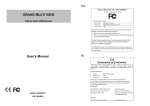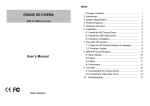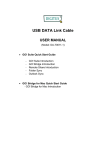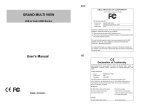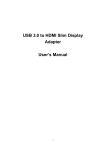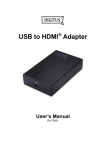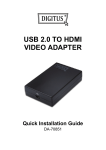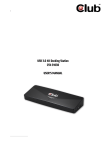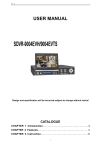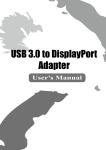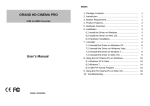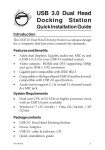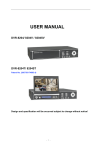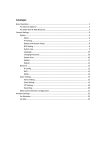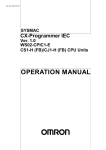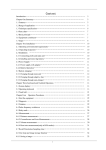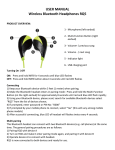Download USB3VGA0S User`s Manual
Transcript
USB 3.0 to VGA Slim Display Adapter User’s Manual 1 ABOUT THIS MANUAL This manual is designed for use with the USB 3.0 to VGA Slim Display Adapter. Information in this document has been carefully checked for accuracy; however, no guarantee is given to the correctness of the contents. The information in this document is subject to change without notice. The manufacturer does not make any representations or warranties (implied or otherwise) regarding the accuracy and completeness of this document and shall in no event be liable for any loss of profit or any commercial damage, including but not limited to special, incidental, consequential, or other damage. Before attempting to connect, operate or adjust this product, please save and read the User's Manual completely. The style of the product shown in this User's Manual may be different from the actual unit due to various models. SAFETY INSTRUCTIONS Always read the safety instructions carefully: Keep this User’s Manual for future reference Keep this equipment away from humidity If any of the following situation arises, get the equipment checked by a service technician: • The equipment has been exposed to moisture. • The equipment has been dropped and damaged. • The equipment has obvious sign of breakage. • The equipment has not been working well or you cannot get it to work according to the User’s Manual. COPYRIGHT This document contains proprietary information protected by copyright. All right are reserved. No part of this manual may be reproduced by any mechanical, electronic or other means, in any form, without prior written permission of the manufacturer. TRADEMARKS All trademarks and registered trademarks are the property of their respective owners or companies. 2 Table of Contents 1. Introduction ........................................................................................5 Features .......................................................................................................5 Package Contents ........................................................................................6 System Requirements..................................................................................7 2. Installation ..........................................................................................9 Parts and connection ...................................................................................9 Driver Installation ..................................................................................... 11 On Windows® XP/ Windows® Vista/ Windows® 7/ Windows® 8 ......... 11 On Mac......................................................................................................13 On Windows® XP/ Windows® Vista/ Windows® 7 / Windows® 8............18 On Mac......................................................................................................19 Using the adapter ......................................................................................21 Utility settings ...........................................................................................21 Description of the settings ........................................................................22 Windows system configuration .................................................................23 Extend mode .............................................................................................24 Mirror mode ..............................................................................................25 Be the primary monitor .............................................................................26 Windows shortcut .....................................................................................26 On Mac......................................................................................................27 Managing Multiple Displays.....................................................................27 Setting the Display Resolutions and Rotation ..........................................27 Setting the Position of Displays ................................................................28 Display Positions ......................................................................................28 Setting the Display to Mirror / Extend mode ............................................29 Changing the Main Display ......................................................................30 3. Advanced operations .......................................................................30 Advanced settings .....................................................................................30 Adjust the resolution .................................................................................31 Extended monitor ......................................................................................31 Mirror monitor ..........................................................................................31 Supported resolution .................................................................................32 3 Using multiple adapters ............................................................................33 Disconnect the adapter ..............................................................................33 4. Uninstall the adapter and driver .....................................................34 5. Troubleshooting ...............................................................................35 6. Specifications ...................................................................................38 7. Regulatory Compliance ...................................................................40 FCC Conditions ........................................................................................40 CE .............................................................................................................40 WEEE Information ...................................................................................40 4 1. Introduction The USB 3.0 Display Adapter is a device which enables connection to second display device to a computer using USB 3.0 port. With this convenient design, it can connect up to 6 display devices to a computer without installing extra video cards. Once the driver has been installed, the USB attached monitor will be enabled immediately. No function key on the adapter and there is no need to reboot the operating system after unplugging the USB adapter. System performance is an important issue when using multiple monitors. Another benefit of this adapter is that it occupies little computer resource; ensuring users get quality display without comprising computer performance. Features Add-on monitor, LCD or projector through a single USB 3.0 port hot-plug; add or remove monitor without system reboot Small in size, works with all VGA displays. Supports High Resolution up to 2048x1152 Video streaming is supported up to 1080p Extend and Mirror mode support. Resumes from hibernation and suspend modes Supports up to 6 USB display adapters to work simultaneously 5 Package Contents USB 3.0 to VGA Slim Display Adapter x1 USB cable x1 CD (Driver & User’s Manual) x1 Quick Installation Guide x1 6 System Requirements Hardware The minimum requirements for the PC are: With Single Core CPU at 1.2GHz or higher processor clock. Intel® Pentium®/ Celeron® family, or AMD® K6® Athlon®/ Duron® family, or compatible processor 512MB memory At least one USB3.0 port (*) 30Mb of available disk space Super VGA (800 x 600) or higher resolution monitor *Note: Although this adapter supports a USB 2.0 connection, the quality might be poor under high resolution display condition. In addition, this adapter does not support USB 1.0/1.1. To play DVD on the adapter-attached monitor, except the requirements above, the following requirements should also be met: With dual core CPU at 2.0 GHz processor clock The adapter screen resolution be set to 800x600 with 32bit color. It is recommended to close all other unnecessary applications if the video playback is not smooth. 7 For 1-2 monitors, business usage, productivity target. This may not provide full frame rate DVD playback at full screen. 1.2GHz Single Core CPU 512MB memory For 3 monitors, where 1 could run DVD video while also targeting productivity and business apps. Will support only 1 video of DVD resolution at full screen\ 1.6GHz CPU 1GB memory For 6 screen where 1 screen can run full screen DVD video 1.8GHz Core Duo 1GB memory Software Windows® XP Home or Professional (Including Table edition) SP2 or SP3 *Note: The adapter does not support Windows® XP 64bit Windows® Vista SP1/SP2 (32-bit or 64-bit) Windows® 7 (32-bit or 64-bit) Windows® 8 (32-bit or 64-bit) Mac OS® X v10.6-10.8 8 2. Installation Parts and connection Parts VGA connector: Connect to a desired VGA monitor. To connect different types of monitor, you may need a converter. Micro USB connector: Connect to an available USB connector on a computer. 9 Connection Plug one end of VGA cable into the adapter's VGA connector, and the other end of VGA cable into a VGA connector of monitor. Plug the micro USB connector into the adapter's micro USB connector and the other end into a PC. 10 Driver Installation On Windows® XP/ Windows® Vista/ Windows® 7/ Windows® 8 Caution: DO NOT connect the Ethernet adapter to your computer before you install the provided driver. You will be instructed to do so later. 1. Insert the provided CD into your disc drive. Then locate and double-click the setup.exe file under x:\Driver\Windows where x is your disc drive letter. 2. When you click setup.exe, you could see the screen as below 11 3. The DisplayLink Core Software screen below appears. Be patient with the installation procedure, it may take a while. 4. The DisplayLink Graphics screen below appears 5. Be patient with the installation procedure, it may take a while. 6. Connect the USB 3.0 to VGA Slim Display Adapter to a computer after the driver installation is completed. For connection details, refer to the chapter of Parts and Connection. 7. When the operating system detects the adapter, the reminder message will appear on the system tray as below. 12 Note: Click <Yes> to restart or <No> to manually restart later, if a prompting to restart computer message appears. 8. To change the status of display mode, position the mouse anywhere on the Windows desktop, and then right-click to select <Screen Resolution>. On Mac Caution: DO NOT connect the Ethernet adapter to your computer before you install the provided driver. You will be instructed to do so later. 1. Insert the provided CD into your disc drive. Locate and double-click the Driver folder > Mac folder > DisplayLink_MacOSX_V2.0.dmg to launch the setup program. 2. Select “DisplayLink Software Installer” to begin installing the DisplayLink Driver on your Mac. 13 3. When the following Window appears, please click Continue to install the driver. 4. Please click Continue after reading Software License Agreement. 14 5. Click Agree to continue the installation and quit the installer. 6. Click Install to perform a standard installation of this software on the disk “Macintosh HD 3”. 15 7. Type your password to allow Installer to make changes. And click Continue Installation to install. 8. It will take for a while to install the driver. 16 9. The installation was successful, please click Restart to finfish installing the software. 10. When finished, the installation screen will disappear and you will return to your desktop. 11. Connect the USB to VGA Adapter to your computer and monitor. 17 Verifying the Driver Installation On Windows® XP/ Windows® Vista/ Windows® 7 / Windows® 8 To verify the driver of the adapter, follow the step below to open the Device Manager on Windows operating system. Following the path as below to open the device manager Windows® 8: My Computer\Computer (right click)\ Properties\Device Manager Windows® 7: Control Panel\System and Security\System\Device Manager. Windows® Vista: Control Panel\System Maintenance\Device Manager Windows® XP: Control Panel\System\Hardware\Device Manager A string similar to USB.. Adapter device should be listed. 18 ® The screen shot above is demonstrated by Windows 7 and might be varied slightly for each operating system. Note: If there is a (question) or (exclamation) mark next to that item, then the driver is not properly installed. Please delete the item, unplug the adapter and repeat the installation steps. On Mac To verify the driver of the adapter, follow the below steps to open the About this Mac on Mac® 1. When the screen below appears and click More Info… 2. When the screen below appears, please click System Report… 19 3. You will find that a new Ethernet network interface is available. It’s usually named USB 3.0 to VGA Adapter. 20 Using the adapter There are several ways to utilize the monitor attached on the adapter. The add-on monitor can be configured to use either “mirror mode”, “extended mode” or be the primary display as described in this section. 1. Mirror mode: Duplicate the primary display and mirror to the add-on monitor(s). 2. Extended mode: The Windows Desktop will be spread to the add-on monitor(s). 3. Primary mode: Assign the add-on monitor to the primary display. Note that the following screen shots in this section are using Windows® 7 operating system. It may not match your operating system but the definitions of buttons, tabs and menus are the same. Utility settings The supplied utility allows you to configure the display mode, screen rotation, screen resolution, and physical arrangement of your monitors. 1. (utility icon) > in the Windows System Tray. Click < Note: The may be hided in the Windows System Tray. Click < 2. (arrow icon) > to bring up more icons if it happens. Select a preferred option, and then click it using mouse. 21 Description of the settings Options Description DisplayLink Enable the Windows screen resolution page. Manager Check for Updates Check the latest driver and download if available. USB 3.0 to VGA Slim Display Adapter Screen Click to select an available resolution. Note that this function is Resolution invalid in mirror mode, as the resolution is defined as the resolution of the primary monitor. Screen Rotate the screen according to the desired orientation. Rotation Extend To Extend the screen according to the desired orientation. Set as Main Monitor Set this screen to the main screen Notebook Monitor Off Switch the add-on monitor to the main display and turn off the screen of the laptop. Note: This function works only when one add-on monitor is connected. This option will also only appear on laptop. Mirror Duplicate the primary monitor to the monitor which connects with the adapter. Off Turn off the monitor. Optimize for Optimize the video quality when playing back. Text may appear Video less clear when enabling. USB 3.0 to VGA Slim Display Adapter Fit to TV Adjust the size of Windows Desktop on the TV. Note: This function works only when one add-on monitor is connected. Besides, this option will also only work in extended mode. The add-on monitor will change to the extended mode if selecting this option while in mirror mode Audio Setup Enable the Windows audio configuration page. This function works only in specific models. Video Setup Enable the Windows screen resolution page 22 Windows system configuration Position the mouse anywhere on your computer desktop, right-click and select <Screen Resolution> on Windows®7/ Windows® 8, Personalize > Display Settings on Windows® Vista or Properties > Settings on Windows® XP. Alternatively, click < (utility icon) > in the Windows System Tray, and then select DisplayLink Manager or Video Setup. 23 Extend mode 1. Refer to the Windows system configuration section to open the configuration page. 2. In the Display drop-down menu, select the option with the string similar to “DisplayLink Graphics Adapter”. 3. Check the Multiple Displays > Extend these displays on Windows® 7/ Windows® 8, Extend the desktop onto this monitor box on Windows® Vista or Extend my Windows desktop onto this monitor box on Windows® XP 4. Click <OK> to confirm and close the settings screen. 5. Once the setting is completed, simply drag and drop the application icons or the opened windows to the add-on monitor. However, some applications may not support to display on the extended desktop. 24 Cursor disappeared If the status remains in the extended mode but the adapter is disconnected, the desktop will still be panned to the add-on monitor. The cursor may not be found on the primary monitor in such a case. If it happens, connect the add-on monitor through the adapter again or keep moving the mouse. Video playback in extended mode If the video or DVD playback quality is poor or low performance in the extended mode, please playback it on the primary monitor instead of the add-on monitor. Mirror mode 1. Refer to the Windows system configuration section to open the configuration page. 2. In the Display drop-down menu, select the option with the string similar to “DisplayLink Graphics Adapter”. 3. Check the Multiple Displays > Duplicate these displays on Windows® 7/ Windows® 8, uncheck the Extend the desktop onto this monitor box on Windows® Vista or Extend my Windows desktop onto this monitor box on Windows® XP 4. Click <OK> to confirm and close the settings screen. 25 Be the primary monitor 1. Refer to the Windows system configuration section to open the configuration page. 2. In the Display drop-down menu, select the option with the string similar to “DisplayLink Graphics Adapter”. 3. Check the Make this my main display box on Windows®7/ Windows® 8 / Windows® Vista, or Use this device as the primary monitor box on Windows® XP Note: Some PCs and laptops may need to disable the main display (i.e. uncheck the Extend the desktop onto this monitor or Extend my Windows desktop onto this monitor box for the main display) as part of the same settings change. 4. Click <OK> to confirm and close the settings screen. Windows shortcut Press < (Windows) > + <P> button to bring up the menu as below, and then select a desired option. *Actual strings depend on your operation system. These screen shots are from Windows® 7 and might vary slightly for each operation system. 26 On Mac Managing Multiple Displays When attaching a display that the software has not seen before, the display will default to being extended to the right of the main display. To configure the settings for each of your USD attached displays, select “Displays” from the “System Preferences” Menu. This will open a “Display Preferences” window on each of your attached displays allowing you to comfiture each display as required. It is possible to use the “Gather Windows” button to bring all the “Display Preferences” Windows on to the main display. Setting the Display Resolutions and Rotation To change the display’s resolution, select an available resolution from the Display Preferences windows of the display you wish to change. The resolutions available depend on both the DisplayLink enabled product and the capabilities of the connected display. If you wish to rotate your display, you can configure the orientation using the “Rotate” drop down. Select the appropriate angle of rotation to match you display’s set up. Each time the user rotates, any settings made to the mode, resolution, frequency or depth are remembered the next time the user switches back to that angle of rotation. 27 Setting the Position of Displays If your computer is connected to more than two displays, you can specify that some are mirrored displays and others show the extended desktop. A mirrored display shows the same content as the main display whereas an extended display will be an extension to your existing desktop. You can arrange your displays so that they match the physical layout of your displays by selecting the “Arrangement” pane within Display Preferences. This ensures that you can easily navigate between all connected displays. Display Positions To move the position of a display, click and hold the display you wish to move then drag it to the desired position. The display will be highlighted with a red border whilst you are moving the display to its new position. 28 Setting the Display to Mirror / Extend mode When in Mirror mode, additional displays will display what is being shown on the primary display. Checking the “Mirror Display” on the “Arrangement” pane enables this feature. To extend connected displays, make sure that the “Mirror Display” on the “Arrangement” pane is unchecked. To work with both extended and mirrored displays, turn off mirroring then in the Arrangement pane press and hold “cmd” and “alt” and drag and drop the display uour wish to mirror over the primary display. 29 Changing the Main Display You can change which is the main display by moving the Menu Bar between displays. Changing the main display affects where new windows appear and the position of the Dock. The “Menu Bar” cab be moved so that it is shown on an alternative display. Clicking the white menu bar and dragging it to the desired display will perform this action. 3. Advanced operations Advanced settings 1. Refer to the Windows system configuration section to open the configuration page. 2. To change the refresh rate or other options, click <Advanced settings>. For more detailed adjustments, refer to the instruction manual of operating system. 3. Click <OK> to confirm and close the settings screen. 30 Adjust the resolution Extended monitor By default, the adapter will configure the settings for the add-on monitor automatically, such as screen resolution, color quality or refresh rate etc. However, these settings can be configured by user as well. The maximum resolution and refresh rate are depending on specifications of the monitors. Mirror monitor In mirror mode, both monitors will be configured to the same resolution, which may not be the maximum resolution of the monitors. The resolution of the primary and add-on monitors may be changed to a lower resolution. For example, if the primary monitor does not support the resolution of 1920x1080, then 1920x1080 is not possible to set even the connected adapter supports 1920x1080. 31 Supported resolution *Note that interlaced modes and reduced blanking modes are not supported. 32 Using multiple adapters Up to 6 adapters can be connected to one computer simultaneously. To connect multiple adapters, install the drive as described in the Installation section and then connect the adapters to a computer. Note: Only the first connected adapter can be configured to extended mode and the others will be forced to mirror mode if using a low-end or poor conditional computer. Disconnect the adapter The add-on monitor goes blank when the operating system goes into standby, hibernate mode or even disconnection. All windows and icons will move to the primary screen. Once the system is activated or reconnected again, the display mode will return to the previous mode before disconnecting. However, some windows or icons may not remove back to the screen of add-on monitor. 33 4. Uninstall the adapter and driver 1. Open the Control Panel > Programs > Programs and Features on Windows® 7 / Windows® 8 / Windows® Vista, and Add or Remove Programs on Windows® XP. 2. Select <DisplayLink Graphic> and click <Uninstall or Remove> 3. Click <Yes> to remove the driver. 4. Click <Yes> to restart your computer and then unplug the adapter now. 34 5. Troubleshooting Q: The display on the add-on monitor is blank. A: If the monitor power is on (LED lights green in most cases), wait a moment for the monitor to show the video as sometimes it takes time for the add-on monitor to show the video. You can also reboot your system to try again. Also make sure the computer is not in standby or hibernation mode, which will lead the add-on monitor to be blank. If the monitor power is in standby (LED lights red in most cases), check the connection. If problem still exists, uninstall the driver, unplug the adapter and re- install the driver again. Q: The add-on monitor is flickering. A: This is usually caused by a low refresh rate. To solve this problem, refer to the steps below. In mirror mode, increase the refresh rate of the main monitor. This will in turn increase the refresh rate of the add-on monitor. In extended mode, increase the refresh rate of the add-on monitor Q: When playing a MPEG file by Windows Media Player on the extended monitor, the display becomes abnormal when switching it to full screen mode? A: Upgrade the Windows® XP from SP1 to SP2. 35 Q: When playing the video in full screen mode, the motion is not smooth. A: Reduce the resolution of the display to 640x480 or 800x600. Use the adapter in extended mode. Terminate any other CPU intensive applications running on the computer. As some media players require DirectX hardware support to correctly operate, try a different media player which requires less DirectX support. Drag the media player to the add-on screen and close the player. Restart the player and it should open on the add-on monitor. Now try playing the media file again. Try reducing the hardware acceleration level of the primary display (NOT the add-on monitor) to levels 1, 2 or 3 and restarting the media player. The hardware acceleration can be found by right-clicking on your desktop and click Properties > Settings > Advanced > Troubleshoot. Some players use this setting even when playing on a different display. The video playback may be unusual when the add- on monitor is mirroring the primary display and there is another extended screen connected to the computer. The extended screen must be disabled before the content will be correctly cloned to the add-on monitor. Q: In extended mode, the add-on monitor appears to have a black border around the desktop. A: This happens when the resolution used by the add- on monitor is larger than the resolution used by the primary monitor. To solve this problem, configure the add-on monitor to use the same resolution as the primary monitor. 36 Q: Full screen menus may corrupt or lose the level of detail. A: It may appear when the resource of computer does not enough to render the screen in full quality. It may also occur when the Optimize for video is enabled through the DisplayLink GUI. Disable the Optimize for video, or turn off unnecessary programs. Set the power plan to High performance when using laptop. Q: Hardware acceleration may not available to applications. A: Check the table below for more supported information. 37 6. Specifications Host Interface USB 3.0 Video Interface VGA Video output: VGA female connector Connectors Host upstream link: USB 3.0 Micro B type connector Connectivity Up to 6 adapters on a computer RAM 512Mb DDR2 SDRAM Power Mode Bus-powered Power Consumption Operating Power: 340 mA approx. Operating system Support Windows® XP Home or Professional SP2 or SP3, Windows® Vista SP1 or SP2 (32- bit or 64-bit), Windows® 7 (32-bit or 64bit), Windows® 8 (32-bit or 64-bit), and Max OS® X v10.6-10.8 Supported Modes Extended Desktop (Default), Mirrored Desktop, Primary Display Housing PC + ABS Plastic Operation temperature : 0 ~ 40 °C Working Environment Storage temperature : -20 ~ 70 °C Certification : FCC, CE Relative Humidity <85% non-condensing Separated from the body USB Cable Type: USB 3.0 Type A (Male) to Micro USB 3.0 (Female) 38 Resolutions, Refresh rate and color depth Note that interlaced modes and reduced blanking modes are not supported. 39 7. Regulatory Compliance FCC Conditions This equipment has been tested and found to comply with Part 15 of the FCC Rules. Operation is subject to the following two conditions: (1) This device may not cause harmful interference (2) This device must accept any interference received. Including interference that may cause undesired operation. Important! Changes or modifications not expressly approved by the manufacturer responsible for compliance could void the user’s authority to operate the equipment. Use an approved phone set. CE This equipment is in compliance with the requirements of the following regulations: EN 55 022: CLASS B WEEE Information For EU (European Union) member users: According to the WEEE (Waste electrical and electronic equipment) Directive, do not dispose of this product as household waste or commercial waste. Waste electrical and electronic equipment should be appropriately collected and recycled as required by practices established for your country. For information on recycling of this product, please contact your local authorities, your household waste disposal service or the shop where you purchased the product. 40








































